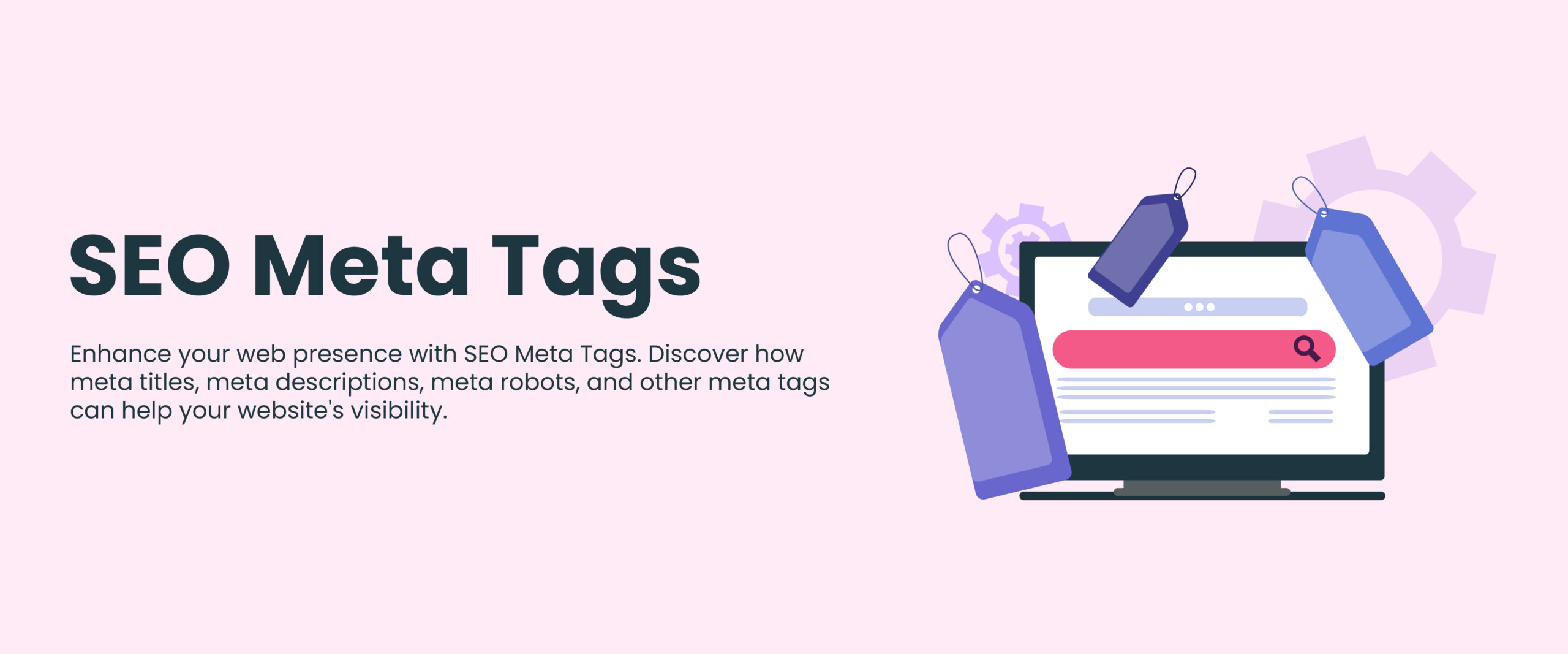SEO Meta Tags – Uses, Types, and More
The proprietors of websites have an unquenchable desire to rise to the top of the internet and attract an army of committed followers who would be enthralled by their digital services. SEO meta tags are the secret to amazing outcomes. These bits of code can boost your website’s search engine rankings, encourage people to click through, and make it stand out from the competition.
What is a Meta Tag in SEO?
SEO meta tags are HTML codes that provide search engines and website visitors with information about a webpage. They are extremely important in optimizing a website for search engine results. The title tag, which sets the title of a webpage, and the SEO meta description tag, which offers a concise overview of the web page’s content, are the most essential meta tags. There are other meta tags for providing keywords, authorship, viewport settings, and other information. Website owners may boost their site’s visibility in search engine results and click-through rates by attracting relevant visitors by carefully employing meta tags. You can learn more about SEO from an online digital marketing course.
Why Use SEO Meta Tags?
SEO meta tags are used for a variety of reasons, including:
- Website Visibility: Meta tags, such as the title and meta description tags, provide search engines with concise information about the content of a webpage. Meta tags that are well-optimized can increase a website’s visibility in search engine results, making it more likely to be discovered by visitors searching for relevant keywords.
- Click-through- rates: A well-crafted meta tag may entice visitors to click on a webpage in search results by providing an intriguing and complete summary. Users are more likely to click on a result that fits their search intent and promises relevant information, resulting in higher click-through rates.
- Preview: Meta tags allow website owners to concisely describe the content and relevance of a webpage to search engines and users. A well-designed title tag and SEO meta description can provide a concise preview of the page’s content, assisting viewers in understanding what the webpage offers and whether it meets their needs.
Explore the best digital marketing course with placement guarantee to excel in all the concepts of digital marketing.
Types of SEO Meta Tags
Meta tags are used for a variety of purposes in search engine optimization (SEO) and web development. Here are some of the common types:
1. Title Tag
The title tag is an HTML element that determines a webpage’s title.
- It appears at the top of a browser’s window or tab as a clickable headline in search engine results.
- The title tag plays a crucial role in SEO by helping search engines understand the content and relevancy of a webpage.
- It should be concise, and descriptive, and incorporate relevant keywords to capture visitors’ attention and improve search engine results.
- A well-optimized title tag can boost click-through rates, attract organic traffic, and provide a clear indication of the web page’s content to both search engines and visitors.
2. Meta Description
A meta description is an HTML property that briefly overviews a webpage’s content.
- It appears on search engine results pages (SERPs) below the title tag.
- While SEO meta descriptions may not directly affect search engine rankings, they play a crucial role in driving organic traffic.
- An effective meta description should be relevant and within the character limit set by search engines (usually 150-160 characters).
- It should accurately reflect the page’s content and entice users to click the link.
- Relevant keywords and key phrases that match the user’s search query.
- Bolded keywords in the meta description can draw attention to the SERPs and indicate relevancy.
3. Meta Keywords
Meta keywords, an HTML property, were previously used to define a list of relevant keywords or phrases for a webpage’s content.
- They aimed to help search engines comprehend the main subjects and themes covered on the page.
- Over time, the significance of meta keywords in search engine rankings has significantly diminished.
- Search engines, like Google, now prioritize contextual relevance and high-quality content over meta keywords.
- Algorithms analyze a webpage’s overall content, structure, and user signals to determine its relevance to search queries.
4. Meta Robots
Meta robots, an important HTML element, guide search engine crawlers as they navigate web pages.
- It manages crucial aspects such as indexing, link tracking, and access controls through various commands.
- The “index” and “follow” directives allow search engines to index pages and follow their interconnected links.
- The “noindex” and “nofollow” directives prevent unwanted indexing and link tracking.
- The “noarchive” directive prohibits search engines from caching the page.
- Meta robot tags empower website owners to control their search engine visibility and maintain indexing and link equilibrium across their domains.
5. Canonical Tag
The canonical tag is an HTML element that helps websites address the issue of duplicate content.
- It establishes the preferred or canonical version of a webpage when multiple URLs have similar content.
- Ensures that search engines understand which URL to index and display in search results.
- By specifying the canonical URL, website owners consolidate ranking signals for a single page.
- Implementing the canonical tag prevents penalties associated with duplicate content and enhances search engine visibility.
- Serves as a guardian, orchestrating optimal SEO performance and maintaining content integrity.


6. Open Graph Tags
Open Graph tags are HTML meta elements used to optimize the appearance of a webpage when shared on social networking sites.
- They provide specific information about the web page’s content, including the title, description, image, and URL.
- Social media platforms utilize Open Graph tags to generate visually appealing previews when the page is shared.
- Website owners have control over how their content appears on social media by customizing Open Graph tags.
- Optimizing Open Graph tags can increase the visibility and click-through rates of shared content on social networking sites.
7. Viewport Tag
The viewport tag is an HTML meta tag that determines how a webpage is displayed and scaled on different devices and screen sizes.
- It is essential for responsive web design to ensure optimal presentation across various platforms.
- The viewport tag specifies the width and initial scale of the viewport, allowing the webpage to adapt to different screen resolutions.
- By utilizing the viewport tag, website owners can enhance the user experience across devices, providing a consistent and user-friendly interface.
- Whether accessed on computers, smartphones, or tablets, the viewport tag ensures that the webpage is properly displayed and optimized for each screen size.
8. Authorship Tag
The authorship tag, also known as rel=” author,” linked an author’s profile to their web content.
- It provided authorship attribution and increased credibility.
- Search engines displayed author information like name, photo, and bio in search results.
- However, major search engines, including Google, have reduced support for the authorship tag.
- Authorship and credibility are now assessed through other factors such as authorship signals and overall content quality and reputation.
Conclusion
SEO meta tags are lines of code that contain the intriguing secrets to increasing search engine exposure, increasing click-through rates, and providing an engaging online experience. Meta embraces the creativity of creating fascinating meta tags and watches your online eminence rise to astounding new heights.







